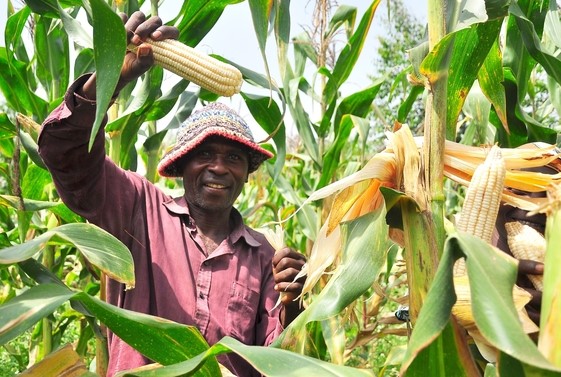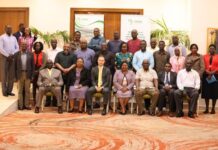Few places depend on maize cultivation as much as Malawi, one of the world’s poorest countries.
Around 80% of households are rural, and most of them grow rainfed white maize on plots averaging just one hectare, primarily for their own subsistence but also to generate some cash.
According to David McKee’s grain industry consultancy from Key International LCC, a record crop of 4.2 million tonnes in the 2020-21 growing season was more than enough to feed the population of 20.8 million, even allowing some surplus for exports and to boost government reserves.
LCC provides market research, feasibility analysis, technical studies and project guidance to companies and organizations.
“Overall production has increased only marginally in the last 15 years. From 2017 to 2021 the average annual maize harvest was 3.4 million tonnes versus 3.3 million tonnes in the period from 2007 to 2011,” he said.
During the same period, the number of Malawians has expanded by over 50%.Current population growth rate of 2.3% is among the highest globally, even though Malawi is already one of the most densely inhabited African nations. Its population is 7% larger than neighboring Zambia’s but with only 16% of the land area, even when including the one-fifth that is Lake Malawi, Africa’s third largest freshwater body.
“The country’s democratically elected government has a long history of supporting maize production with two major forms of subsidy: fertiliser distribution and maize procurement at a minimum support price,” said McKee.
The two largely untargeted and highly controversial schemes eat up substantial amounts of annual budget spending for social causes.
McKee added: “The Agricultural Development and Marketing Corp. (ADMARC) is the state-owned entity that is charged with buying maize from farmers at a minimum support price.Thanks to a bumper crop, the parastatal managed to procure 240,000 tonnes in its fiscal year ended March 31, 2022.
“Ideally the procurement should be done when prices are falling during the harvest period that starts in March and April.But the reality is that every year ADMARC, which has chronic funding difficulties, only starts buying in earnest months after the harvest when prices already are rising during the lean season. Most of the maize comes from private traders who accumulate speculative stocks from cash-hungry farmers at the time of harvest when prices were lowest.”
At least every few years the government must bail out ADMARC to repay its short-term commercial bank borrowings. Already in early 2022 the new general manager, Rhino Chipiko, was asking the government for a kwacha 50 billion (US$40 million) bailout in order to recapitalize after years of operating losses, very often resulting from fraudulent trading and insider dealings.
ADMARC owns the largest network of warehouses in the country, totaling 300,000 tonnes of storage capacity at 400 sites. However, most of these sites are uneconomical due to remote locations and low volumes of maize and other crops delivered.Only the dozen or so large warehouse sites constituting district hubs are commercially viable.
A separate entity, the National Food Reserve Agency (NFRA), can store emergency and market intervention stocks of up to 180,000 tonnes in its massive concrete silo complex built in 1979 outside of Lilongwe. However only two-thirds of the silo capacity is usable, and two of the three NFRA regional storage sites, with 20,000 tonnes of steel silo capacity each, have never operated since construction nearly 10 years ago.
It is fortunate that the government is holding its largest maize reserve stocks in years. In April, the Ministry of Agriculture estimated the 2022 maize crop at just 3.1 million tonnes due to the lowest precipitation recorded in decades during the October to January onset of the rainy season combined with a crop destroyed by subsequent flooding. Lower fertilizer application due to skyrocketing prices also will contribute to a smaller crop.
Malawi’s nutrient-weak soil needs enrichment to support the intensive farming needed for a growing population. The government has had schemes in place to subsidize fertilizer distribution for many years.
However, President Lazarus Chakwera, pledged to triple the subsidy by providing two 50-kg bags of fertilizer at around $5 each to all of 3.7 million registered farm households. The cost of the subsidy to the government was about 70% of the per bag cost.
A major success of the subsidy scheme from the standpoint of the private sector suppliers was the use of a digitalized national identity card scheme to record sales of the fertilizer to the authorized beneficiaries.
In the current year, following a doubling of the international fertiliser price, the scheme was scaled back, and actual distribution reached only a fraction of the intended beneficiaries by the onset of the rainy season.
International development partners, including the World Bank, International Monetary Fund (IMF) and donor nations have been critical of the corruption-prone maize and fertilizer subsidies, maintaining the money would be better spent on basic government services such as health, education and roads.
To many informed observers, preoccupation with maize monoculture, despite low yields and prices, is helping to keep Malawi impoverished. Agricultural diversification as a path to development is a major focus for the government with support from World Bank lending and other international development partners.
The entire soybean value chain has become a bright spot thanks to both surging domestic and export demand.
In recent years, soybeans have begun to figure more significantly in Malawians diets. Feed milling has been expanding to meet demand for egg and chicken meats. The biggest poultry company, Capital Foods, is the largest buyer of maize in the country along with ADMARC, but also needs significant quantities of soybeans for animal feed production.
There are now at least eight companies producing textured soy pieces. It was introduced by Export Trading Group as a new food product over 10 years ago to be enjoyed as a low-cost relish high in vegetable proteins to accompany the standard fare of maize meal a couple times per day. Daily soybean equivalent requirement of these processors has grown to a few hundred tonnes. Soybean oil for human consumption and substandard beans and soy pieces for use in animal feed are valuable byproducts.
Export demand for soybeans posed a challenge to the domestic processors in 2021.A short crop in India led to CIF Mumbai prices climbing to over $1,000 per tonne in August 2021 before collapsing. Traders in Malawi paid steadily higher prices throughout the summer and into the fall to buy up the last remaining quantities to fill the demand.
Much of these export quantities may have originated in Zambia and Mozambique, where oilseed processors through their associations can veto legal soybean exports but can do little to stop the informal trade across porous borders.
Malawian exporters struggled to find enough trucks and containers to move the several thousand tons of soybeans from the landlocked country to Nacala and Beira ports in Mozambique and to Dar es Salaam for shipment to Mumbai.
Thanks to a price at 2.5 times that of maize, farmers are bound to plant more soybeans and less maize, accelerating the trend of export-led agricultural diversification.
The challenge is to increase productivity and yields.
The pending commercial release of new soybean varieties, developed in a five-year USAID funded project, has the potential to more than double yields from less than two tonnes per hectare to over four tonnes among large commercial farmers.









